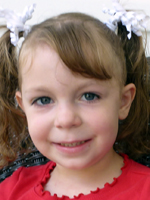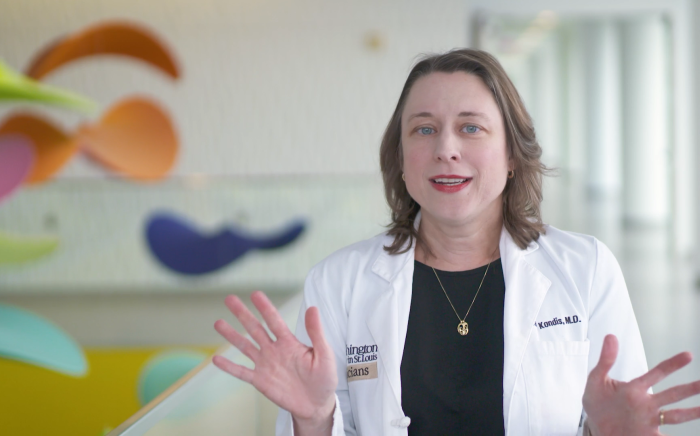 Even though Crissy Patterson was a first-time mom, as a nurse, she knew there was something not-quite-right about her newborn daughter, Emery. Despite repeated assurances from her pediatrician, Crissy could not understand why Emery was draining eight ounces of formula every three hours and still not gaining weight. She also knew that the yellow tint to the whites of her eyes were outside the range of “normal.”
Even though Crissy Patterson was a first-time mom, as a nurse, she knew there was something not-quite-right about her newborn daughter, Emery. Despite repeated assurances from her pediatrician, Crissy could not understand why Emery was draining eight ounces of formula every three hours and still not gaining weight. She also knew that the yellow tint to the whites of her eyes were outside the range of “normal.”
“We were living about an hour outside of New York City at the time,” says Crissy. It was a couple of days before Christmas, and we were getting ready to head back to the Midwest to visit our families. Deep down, I just knew that there was a problem with Emery. I insisted that our doctor draw some blood and find out what was going on. When the labs came back, my doctor called and said the results were not good and we needed to take Emery to a different hospital for further testing.”
What started as a routine day filled with preparations for holiday travel turned into two lengthy visits at different hospitals and a battery of tests for Emery. Doctors suspected cystic fibrosis or biliary atresia—an inflammation of the large bile ducts outside the liver that irreversibly blocks bile flow from the liver to the small intestine.
“Once they mentioned biliary atresia, I conducted an Internet search to learn more. I just knew in my heart this is what she had—Emery hit several marks. And the more I read, the more frightened I became as I realized she would eventually need a liver transplant. It was devastating. We started making phone calls, and doing further research. We asked friends and other health care professionals to recommend the best place to take our baby girl. My husband Will and I agreed that Emery needed to be at a medical center that had a lot of experience with biliary atresia patients.”
Crissy and Will were relieved to discover Mt. Sinai hospital in New York City was part of the Biliary Atresia Research Consortium (BARC)—a nationwide, multi-center network that receives funding from the National Institutes of Health to study biliary atresia. “We packed Emery up again and made the 45-minute trip to Mt. Sinai—our third hospital in four days. We were so scared. I remember looking at Emery in her car seat and thinking what will we do if something happens to her? Will this car seat be empty when we leave the hospital?”
Doctors at Mt. Sinai confirmed Emery’s biliary atresia. On December 24, surgeons performed a Kasai procedure. “The Kasai procedure allows for drainage of bile from the liver,” says Jeffrey Lowell MD, Surgical Director of the Liver Care Center at St. Louis Children’s Hospital. “For most patients, the Kasai procedure is a temporary solution. The vast majority of children will eventually require a liver transplant.”
While Emery’s bile was now able to flow out of her liver, doctors cautioned that it would take three months to see whether the procedure was a success. “Emery was sent home with some awful-smelling special formula—which she quickly refused to drink—and nine different daily medications. Juggling her care and medications was challenging, even with my medical training,” says Crissy
As Emery’s liver counts started coming down, her dad was tapped for a job promotion. As luck would have it, this new opportunity was close to another participating BARC facility—St. Louis Children’s Hospital. But before Emery made it to her first appointment with her new doctors in St. Louis, she spiked a fever. Emery and her parents were on the road, visiting family. What first appeared to be a simple ear infection was actually a widespread bacterial infection as a result of cholangitis, a commonly occurring complication of a Kasai procedure.
“Testing revealed bile pools in her liver, says Crissy. “All we wanted to do was get her to St. Louis Children’s Hospital. After a lot of back-and-forth with the out-of-town doctors, Emery was flown by medical transport to St. Louis. She was in liver failure.”
On May 19, 2008, Emery was placed on the list for transplant. Over the next several weeks, her health continued to deteriorate. “She was eating less and sleeping more--almost 18 hours a day. Every night, my husband and I took turns on the floor beside her crib to make sure she was okay.
At 8:30 am on July 24, the family received the call they had been waiting for. “Our transplant coordinator, Penny Scholl told us not to tell anyone yet —we needed to be cautious just in case something didn’t work out. At around 10:30 she called back and said it was a go.”
During the two-hour drive to St. Louis Children’s Hospital, Emery did not sleep. “It was unbelievable,” says Crissy. The same baby who had been asleep more than she was awake did not close her eyes that day—I think she knew what was about to happen. Dr. Lowell even delayed his scheduled vacation for a day to be there for Emery’s surgery.”
“One of the operating room nurses kept coming out to the waiting room throughout the evening to give us updates on how the procedure was going. At 9:30 p.m. she came back out for another update. That’s when we heard it—the sound of a helicopter. The nurse heard it too. She quickly stopped talking and said she had to get back to the O.R. We knew it was Emery’s new liver.”
Within 48 hours of transplant, Emery was out of intensive care and in a regular room. “She did incredibly well. I woke up on the second night after surgery to see her awake and smiling at me in her crib. Her eyes had a sparkle and a shine that had never been there before. We took her home on August 1—just eight days after surgery!”
It goes without saying that Will and Crissy are strong advocates for organ donation. “Emery is our miracle—the donor family provided a miracle for our family.” Dr. Lowell concurs. “Emery is alive today because of an organ donor.”
Now at almost five years old, Emery loves gymnastics, dancing and swimming. “She is fired up for soccer season and is starting Pre-Kindergarten three days a week. She is down to just one medication and monthly blood work—she’s doing beautifully.”
“The doctors and staff at St. Louis Children’s Hospital are miracle workers too,” says Crissy. “Without a donor liver, and such excellent medical care, our son Evan would not have his wonderful big sister, and we wouldn’t have our amazing daughter. We encourage everyone to consider becoming an organ donor.”












